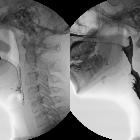Kabuki syndrome
Kabuki syndrome (Niikawa-Kuroki syndrome) is a rare polydysplasia that is thought to be more common in Japan.
Epidemiology
Estimated incidence of 1:32,000 in Japan. Sporadically seen elsewhere in the world. The reason for the disparity in incidence is controversial.
Clinical presentation
- characteristic facies
- long palpebral fissures
- eversion of lower eyelid
- arched eyebrows
- sparseness of lateral half of the eyebrows
- hypertelorism
- epicanthal folds
- protruding ears
- missing and widely-spaced teeth
- "trapezoid philtrum"
- hypotonia
- feeding problems
- intellectual disability (most slight or moderate)
- growth retardation
- prominent finger pads and abnormal dermatoglyphic patterns
- seizures (32%)
- immune system dysfunction
Radiographic features
- skeletal dysplasia (92%)
- clinodactyly of the fifth digit of the hand
- short digits
- spinal deformities
- sagittal cleft of the vertebral bodies
- cleft palate (less common in Japanese cases)
- non-specific cerebral atrophy
Other anomalies have been associated with the syndrome:
- congenital cardiac anomalies
- horseshoe kidney
- precocious puberty
Pathology
In the majority of the patients with Kabuki syndrome, genetic mutation of MLL2 is identified. Other gene mutations causing Kabuki syndrome are reported in the literature including KMT2D inherited in autosomal dominant matter and KDM6A mutation which displayed X-linked dominant inheritance.
Treatment and prognosis
Variable, depending on the degree of neuromuscular dysfunction and organ dysplasia.
History and etymology
"Kabuki" refers to a type of Japanese drama in which the players appear in stylized makeup. Kabuki syndrome was first reported in 1981 by Niikawa and Kuroki in a total of ten unrelated Japanese children with a similar presentation of multiple congenital anomalies and neurologic abnormalities.
Differential diagnosis
References
1. Lederer D, Shears D, Benoit V, Verellen-Dumoulin C, Maystadt I. A three generation X-linked family with Kabuki syndrome phenotype and a frameshift mutation in KDM6A. Am J Med Genet A. 2014 May;164A(5):1289-92. doi: 10.1002/ajmg.a.36442. Epub 2014 Mar 24. PMID: 24664873.
2. Kabuki syndrome, Genetic and Rare Diseases Information Center, August 2016, https://rarediseases.info.nih.gov/diseases/6810/kabuki-syndrome#ref_10585
Siehe auch:

 Assoziationen und Differentialdiagnosen zu Kabuki-Syndrom:
Assoziationen und Differentialdiagnosen zu Kabuki-Syndrom:





